The Lágymányos campus of ELTE
The Lágymányos campus of ELTE

The Northern Building

The lobby of the Southern Building
On the opposite bank, the National Theatre and the Palace of Arts
The campus is located in a bustling scientific district, adjacent to the HUN-REN Centre for Natural Sciences and the buildings of the Budapest University of Technology and Economics. Just a few steps away, the rapidly developing new city center, Buda-part, and the neighboring Infopark host numerous company offices, with cafes and small restaurants at the base of the buildings.

Post-class relaxation is ensured by the shady paths of Gellért Hill, reachable with a ten-minute walk, or the bustling waterfront of Kopaszi Dam, which, in addition to numerous small cafes and restaurants, features a beach and a water sports center. Bartók Béla Road, which connects the Danube with Móricz Zsigmond Square, welcomes students with its small pubs and restaurants.

The Gellért Hill (photo: Csodálatos Budapest)
Next to the Northern Building, the Students' Park provides a place for relaxation. Designed in 2019 to meet the needs of young people, it includes benches and loungers, as well as a basketball court, ping-pong table, and outdoor gym under shady trees. Additional opportunities for sports and exercise are offered by BEAC's sports complex on Bogdánfy Street, the Tüskecsarnok, and the Tüskecsarnok swimming pool, all just a few minutes' walk away.

The Students' Park (photo: ujbuda.hu)

Loungers in the Students' Park (photo: ujbuda.hu)
(Translated by AI)
Access
The Lágymányos Campus has excellent public transport access, with numerous lines available at the Buda end of Petőfi Bridge.
By tram: 4, 6: to Petőfi Bridge, Buda end
By bus: 6, 153, 154, 212A, 212B, 918: to Petőfi Bridge, Buda end, or with 153, 154 to Magyar Tudósok Körútja stop.
From the train stations:
Déli Station: By Metro line 2 (red) to Blaha Lujza Square, then by tram 4 or 6 to Petőfi Bridge, Buda end.
Kelenföld Station: By tram 19 or 49 to Móricz Zsigmond Square, then by tram 6 to Petőfi Bridge, Buda end.
Keleti Station: By Metro line 2 (red) to Blaha Lujza Square, then by tram 4 or 6 to Petőfi Bridge, Buda end.
Nyugati Station: By tram 4 or 6 to Petőfi Bridge, Buda end.
By car from the highways:
M1 (E60, E75), M7 (E71): M1-M7 - Budaörsi Road - Nagyszőlős Street - Bocskai Road - October 23rd Street - Irinyi József Street route.
M3 (E71): M3 - Hungária Boulevard - Könyves Kálmán Boulevard - Lágymányosi Bridge - Pázmány Péter Promenade route.
M5 (E75): M5 - Nagykőrösi Road - Gyáli Road - Könyves Kálmán Boulevard - Lágymányosi Bridge - Pázmány Péter Promenade route.

Services
ATM: The ATM is located inside the Northern Building near the Chemistry reception.
Bicycle Storage: A guarded bicycle parking facility is available in the Northern Building. To use this facility, register at the Chemistry building reception, providing the required information. The bicycle storage is located to the left of the reception, behind a glass door (door number 15), which is opened by the receptionist. Notify the reception when taking the bicycle out. Covered bicycle storage is available in the underground garage. Additional bicycle parking is available outdoors around both the Northern and Southern Buildings.
Dining: There are three cafeterias on the Lágymányos Campus.
- Campus Faloda is located on the ground floor of the old "Chemistry Building" in the Northern Building, rooms 071-072. Opening hours: 7:30 AM - 6:00 PM (until 4:00 PM during exam periods). Hot meals are served at noon, and the current menu is posted on the noticeboards next to the cafeteria.
- Gallery Cafeteria is located on the gallery above the Gömb Hall in the Northern Building. Opening hours: 7:30 AM - 5:00 PM. The menu includes various sandwiches, hot sandwiches, drinks, coffee, etc.
- Southern Cafeteria is located in the Southern Building, next to the Western entrance. Opening hours: 7:30 AM - 5:30 PM (from 8:00 AM on Mondays and until 3:00 PM on Fridays). The menu includes simple hot meals, sandwiches, pastries, drinks, and coffee. The current menu is available in the cafeteria.
Parking:
Parking for Employees and Students
The Lágymányos Campus offers surface and underground parking. The underground garage is available to a limited number of authorized users. Parking is free for all active university members, with license plate-based electronic entry available through the Rollet app. Detailed instructions and registration information can be found here: Parking regulations on the Lágymányos Campus.
Parking for Guests
The host must submit the invited guests' data to sorompo@elte.hu. The barriers will recognize the license plate, and entry will be automatic. For events, especially large ones, it is impractical to collect vehicle and guest data in advance. In such cases, inform the dispatcher via the intercom of the event name, and the barrier will be opened. Use the intercom again to exit.
Questura Customer Service (Q-point): For issues not directly related to academic studies, contact the Quaestura Student Customer Service Office, part of the Service Directorate. The Q-point on the Lágymányos Campus is located on the gallery of the first floor of the Northern Building (opposite the cafeteria). For exact opening hours and more information: qter.hu.
Available Services:
- Student ID card management
- Submission of student loan forms
- Initial Neptun password distribution for students and teachers
- Changing forgotten Neptun passwords for those who cannot use the electronic password change
- Mailing forgotten passwords as described on their site
- Student health insurance management (for foreign students studying on scholarships, from third countries)
- Applying for TAJ cards for foreign students eligible for social security
- Handling student financial matters and issuing financial certificates
- Issuing student status certificates
- Filling out various application forms (for supplementary social-based support for higher education student mobility; for orphan’s allowance evaluation; for GYED extra application)
- Correcting personal data incorrectly entered in Neptun
- Collecting training contracts for courses announced by the ELTE Career Center
- Collecting ELTE Alumni application forms
Library: The combined library collection of Biology, Mathematics, Geography, Earth Sciences, Physics, and Chemistry is located in room 1.809 on the first floor of the Southern Building. Opening hours: Mon-Thu: 9:00 AM - 7:00 PM, Fri: 9:00 AM - 2:00 PM. More information: ttk.elte.hu/konyvtar
Event Venues, Room Rental: Several rooms on the campus are available for event organization. More information can be found here (in Hungarian): rendezvenyhelyszin.elte.hu
Medical Office: The occupational health clinic for ELTE employees is located in the Northern Building, room 0.124/A on the ground floor. Doctor: Dr. Zsuzsa Szanitrik, Occupational Health Specialist. Consultation hours: Tuesdays 12:00 PM – 3:00 PM. Phone: extension 6188
WiFi/IT Services: The ELTE WiFi service is available on the Lágymányos Campus for all ELTE members with an IIG ID. More information about WiFi settings can be found here: www.elte.hu/infoszolg
For assistance, the Operator Service provides help:
- Email: operator@elte.hu
- Phone: +36 1 372 2500/6800
- On the Lágymányos Campus: 1117 Budapest, Pázmány Péter sétány 1/A, VI/126.
The Northern Building
The Northern Building was constructed between 1994 and 1998, designed by István Mányi and Miklós Kiss. The Planetarium on its roof, inaugurated in 2011, is Hungary's first digital observatory, primarily serving the purposes of university education. The building also houses the Mathematical Collection, which is part of the ELTE Natural History Museum. The impressive Gömb Hall of the Northern Building hosts numerous events, including graduation ceremonies.




A Walk in the Gömb Hall
Eötvös Loránd (1848–1919)
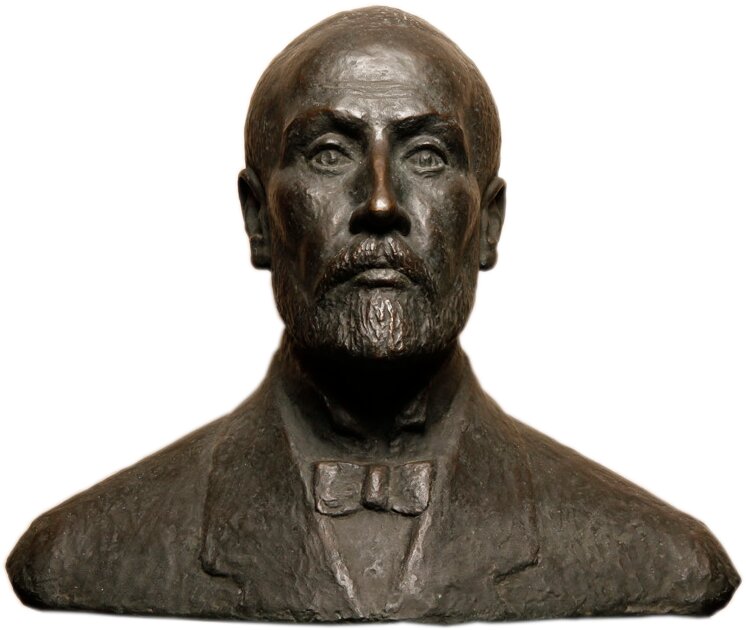
From 1871 until his death in 1919, he was a professor at our university. In 1878, he succeeded Ányos Jedlik as the chair of experimental physics. He served as the university's rector in 1891-92 and was the president of the Hungarian Academy of Sciences (MTA) for 16 years between 1889 and 1905. In the 1870s, he discovered a universal relationship during his research on surface tension, and from 1888, he studied the Earth's gravitational field. He designed a torsion balance to investigate spatial variations in the gravitational field, which allowed him to precisely verify the proportionality of inertial and gravitational mass. His gravitational research made his name known worldwide, and he also implemented high-quality teacher training at our university. As Minister of Culture and president of the Mathematical and Physical Society, he introduced the concept of the scholarly teacher in Hungary. The Eötvös József Collegium, established on his initiative, today provides a worthy place of study and residence for talented university students from the countryside. The annual national physics competition held every autumn, the Physical Society, and the Geophysical Institute all bear his name.
Our university adopted the name Eötvös Loránd University in 1950. The bust of Eötvös Loránd here was created in 1991 by László Csejdy, while all the other statues we will pass by were unveiled in 1999. We will mention the names of their creators at the end of the walk.
As we start walking from Eötvös's statue towards the Hall, whether we turn left or right, we first encounter statues of Eötvös's students.
On the left, the statue closest to Eötvös belongs to Radó Kövesligethy, who led the university's Department of Cosmography from 1904 until his retirement.
Kövesligethy Radó (1862–1934)
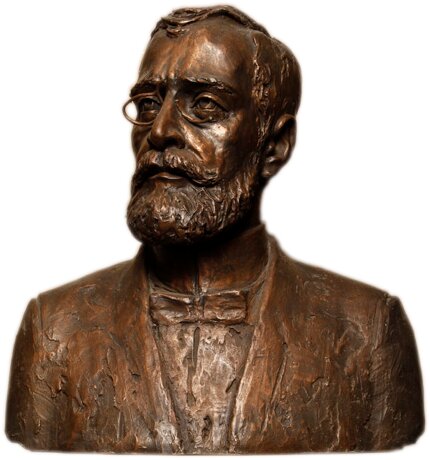 At the University of Vienna, he graduated as an astronomer, with Josef Stefan being one of his professors in physics. Miklós Konkoly-Thege invited him to Ógyalla as an observer, from where he came to Budapest at the invitation of Loránd Eötvös. He became involved in gravitational measurements, served as the physics editor for the Mathematikai és Physikai Lapok, and was the physicist secretary of the Society. His interest gradually shifted towards earthquake research, and he organized the national seismological network. As the secretary-general of the international seismological association, he directed the world's seismological research from Budapest until the outbreak of World War I. The war and the subsequent revolutions disrupted his promising research career, but even after his retirement, he remained an active member of the university's doctoral examination committee. His theoretical physics work remains an exciting challenge for the history of physics research to this day.
At the University of Vienna, he graduated as an astronomer, with Josef Stefan being one of his professors in physics. Miklós Konkoly-Thege invited him to Ógyalla as an observer, from where he came to Budapest at the invitation of Loránd Eötvös. He became involved in gravitational measurements, served as the physics editor for the Mathematikai és Physikai Lapok, and was the physicist secretary of the Society. His interest gradually shifted towards earthquake research, and he organized the national seismological network. As the secretary-general of the international seismological association, he directed the world's seismological research from Budapest until the outbreak of World War I. The war and the subsequent revolutions disrupted his promising research career, but even after his retirement, he remained an active member of the university's doctoral examination committee. His theoretical physics work remains an exciting challenge for the history of physics research to this day.
On the right, the statue closest to Eötvös belongs to Károly Tangl, who succeeded Loránd Eötvös as the head of our university's Institute of Experimental Physics.
Tangl Károly (1869–1940)
 As one of Eötvös's selected students, he became involved in university gravitational measurements during his first year. As a young assistant professor, he utilized his research in potential theory to develop the theoretical background of the measurements. From 1903, he led the Department of Experimental Physics in Cluj, from 1916 at the Technical University in Budapest, and from 1921 at the University of Science. He had an excellent ability to discover talented individuals, whom he then helped to start and advance their careers in the national and international physics community. In Cluj, his best students and young colleagues were Zoltán Gyulai and Rudolf Ortvay, at the Technical University Kornél Lánczos, and at our university Jenő Barnóthy and Magdolna Forró. His university textbook on experimental physics, based on Eötvös's lectures, was widely used throughout the country. In the last five years of his life, he was the president of the III. (Mathematical and Physical) Section of the Academy.
As one of Eötvös's selected students, he became involved in university gravitational measurements during his first year. As a young assistant professor, he utilized his research in potential theory to develop the theoretical background of the measurements. From 1903, he led the Department of Experimental Physics in Cluj, from 1916 at the Technical University in Budapest, and from 1921 at the University of Science. He had an excellent ability to discover talented individuals, whom he then helped to start and advance their careers in the national and international physics community. In Cluj, his best students and young colleagues were Zoltán Gyulai and Rudolf Ortvay, at the Technical University Kornél Lánczos, and at our university Jenő Barnóthy and Magdolna Forró. His university textbook on experimental physics, based on Eötvös's lectures, was widely used throughout the country. In the last five years of his life, he was the president of the III. (Mathematical and Physical) Section of the Academy.
Let's continue to the right! After Károly Tangl's statue, we come to the statue of Rudolf Ortvay.
Ortvay Rudolf (1885–1945)
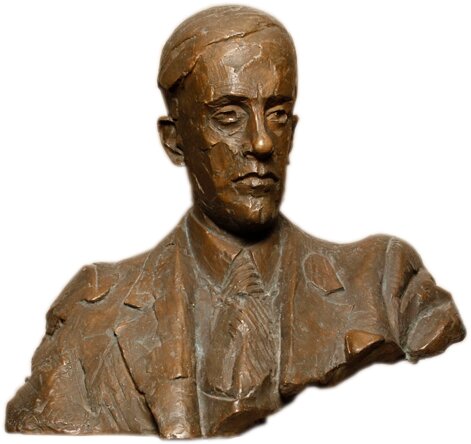 He attended university in Budapest and Göttingen, and earned his PhD in physics in Cluj. With the help of Károly Tangl, he received scholarships to study with Debye in Zurich and Sommerfeld in Munich. He became a professor of theoretical physics in Cluj and later, after the Treaty of Trianon, in Szeged. Again with Károly Tangl's assistance, he joined the Department of Theoretical Physics at our university in Budapest in 1928. It is largely thanks to him that Hungarian theoretical physics reached the world-class level. He maintained close relationships with Hungarian physicists working at foreign universities. He organized physical colloquia to discuss the latest theories, inviting speakers such as John von Neumann, Eugene Wigner, Kornél Lánczos, Edward Teller, and László Tisza to Hungary. His university textbook, "The Corpuscular Theory of Matter," written in the spirit of quantum mechanics, which had been discovered just 1-2 years earlier, was published in 1927. He was an extremely well-read, broad-minded individual who delighted in exploring fields beyond physics, including mathematics, astronomy, biology, philosophy, and even archaeology.
He attended university in Budapest and Göttingen, and earned his PhD in physics in Cluj. With the help of Károly Tangl, he received scholarships to study with Debye in Zurich and Sommerfeld in Munich. He became a professor of theoretical physics in Cluj and later, after the Treaty of Trianon, in Szeged. Again with Károly Tangl's assistance, he joined the Department of Theoretical Physics at our university in Budapest in 1928. It is largely thanks to him that Hungarian theoretical physics reached the world-class level. He maintained close relationships with Hungarian physicists working at foreign universities. He organized physical colloquia to discuss the latest theories, inviting speakers such as John von Neumann, Eugene Wigner, Kornél Lánczos, Edward Teller, and László Tisza to Hungary. His university textbook, "The Corpuscular Theory of Matter," written in the spirit of quantum mechanics, which had been discovered just 1-2 years earlier, was published in 1927. He was an extremely well-read, broad-minded individual who delighted in exploring fields beyond physics, including mathematics, astronomy, biology, philosophy, and even archaeology.
After Ortvay's statue comes the statue of György Békésy.
Békésy György (1899–1972)
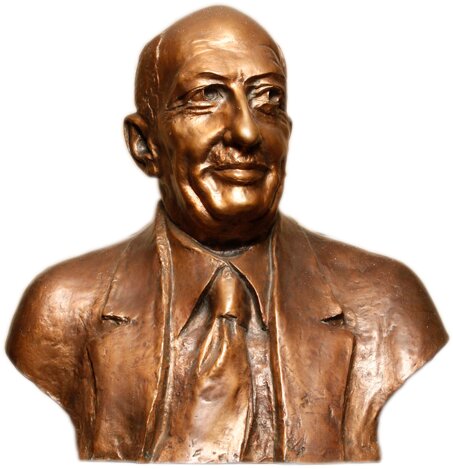 He earned a degree in chemistry in Bern and then received his PhD in experimental physics in Budapest under Károly Tangl. He then took a position at the Postal Experimental Station, where he began his world-renowned research on the functioning of the human auditory system. In 1940, after the death of Károly Tangl, István Rybár, who had been leading the Institute of Practical Physics, took over the Institute of Experimental Physics, and the university invited György Békésy to fill Rybár's position. Békésy accepted the offered chair on the condition that he could also retain his chief engineering position at the Postal Experimental Station. As the head of the institute, he maintained good relations with students, who had free access to the library and laboratory. At the end of World War II, during the siege of Budapest, he entrusted his most valuable instruments to these students, instructing them to take them home and hide them. After 1945, he went on study trips to Sweden and the United States, and in 1949, the proletarian dictatorship terminated his positions in Hungary and even revoked his membership in the Academy. He never returned to Hungary. In 1961, he was awarded the Nobel Prize in Physiology for his research on the mechanism of human hearing, much of which had been conducted in Hungary. This statue, which depicts a cheerfully smiling György Békésy, can also be seen as a portrait of a scientist who rose above the biased and foolish political decisions of the time.
He earned a degree in chemistry in Bern and then received his PhD in experimental physics in Budapest under Károly Tangl. He then took a position at the Postal Experimental Station, where he began his world-renowned research on the functioning of the human auditory system. In 1940, after the death of Károly Tangl, István Rybár, who had been leading the Institute of Practical Physics, took over the Institute of Experimental Physics, and the university invited György Békésy to fill Rybár's position. Békésy accepted the offered chair on the condition that he could also retain his chief engineering position at the Postal Experimental Station. As the head of the institute, he maintained good relations with students, who had free access to the library and laboratory. At the end of World War II, during the siege of Budapest, he entrusted his most valuable instruments to these students, instructing them to take them home and hide them. After 1945, he went on study trips to Sweden and the United States, and in 1949, the proletarian dictatorship terminated his positions in Hungary and even revoked his membership in the Academy. He never returned to Hungary. In 1961, he was awarded the Nobel Prize in Physiology for his research on the mechanism of human hearing, much of which had been conducted in Hungary. This statue, which depicts a cheerfully smiling György Békésy, can also be seen as a portrait of a scientist who rose above the biased and foolish political decisions of the time.
The next statue depicts our university's other Nobel Prize-winning professor, György Hevesy.
Hevesy György (1885–1966)
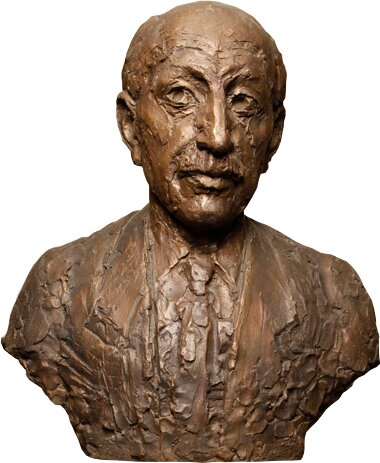
From the direction of György Hevesy's statue towards the southern entrance of the Hall, we see statues of four chemists: two on the right and two on the left of the entrance. Next to György Hevesy's statue is the statue of Béla Lengyel Sr., and opposite him on the other side is the statue of Károly Than. Closest to the entrance are the statues of two of Than's students, Lajos Winkler and Gusztáv Buchböck.
Continuing in the same direction, after György Hevesy's statue, we come to the statue of Béla Lengyel Sr.
id. Lengyel Béla (1844–1913)
 He studied in Heidelberg with Bunsen around the same time as Loránd Eötvös. However, he was already a scholarship recipient there, having been an assistant to Károly Than for two years prior. In Hungary, he became a private lecturer at our university in 1870, and from 1877, he led the newly established II. Chemical Institute. Here, he enthusiastically conducted chemical analyses of the country's mineral waters. He was also actively involved in the Natural Science Society. He was one of the first chemists to work with radioactivity, which is why his statue is placed next to that of György Hevesy.
He studied in Heidelberg with Bunsen around the same time as Loránd Eötvös. However, he was already a scholarship recipient there, having been an assistant to Károly Than for two years prior. In Hungary, he became a private lecturer at our university in 1870, and from 1877, he led the newly established II. Chemical Institute. Here, he enthusiastically conducted chemical analyses of the country's mineral waters. He was also actively involved in the Natural Science Society. He was one of the first chemists to work with radioactivity, which is why his statue is placed next to that of György Hevesy.
On the right side of the southern entrance stands the statue of Gusztáv Buchböck.
Buchböck Gusztáv (1869–1935)
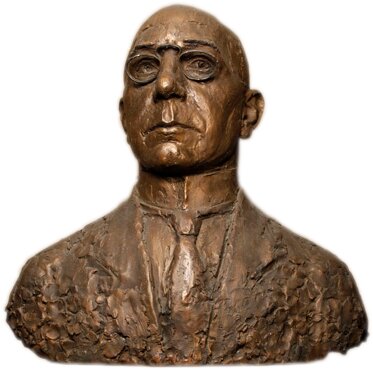 In 1904, he became a private lecturer at our university. He went on study trips abroad to the institutes of Wilhelm Ostwald and Walter Nernst, and worked alongside Károly Than in Hungary. After Than's death in 1908, his institute was divided, and Buchböck was appointed head of the newly organized III. Chemical Institute. He subsequently gathered many talented young chemists around him and introduced them to the increasingly refined world of physico-chemical measurements. György Hevesy and Tibor Erdey-Grúz also worked with him and started their careers there.
In 1904, he became a private lecturer at our university. He went on study trips abroad to the institutes of Wilhelm Ostwald and Walter Nernst, and worked alongside Károly Than in Hungary. After Than's death in 1908, his institute was divided, and Buchböck was appointed head of the newly organized III. Chemical Institute. He subsequently gathered many talented young chemists around him and introduced them to the increasingly refined world of physico-chemical measurements. György Hevesy and Tibor Erdey-Grúz also worked with him and started their careers there.
Walking over to the other side of the southern entrance, we come to the statue of Lajos Winkler.
Winkler Lajos (1863–1939)
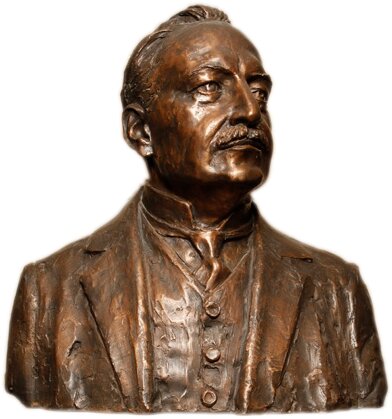 He graduated as a pharmacist and earned a doctorate in pharmacy at our university under the guidance of Károly Than. In 1893, he became a private lecturer, and in 1903, a full professor. After the death of Károly Than, the institute was divided, and the half that retained the name I. Chemical Institute was led by Lajos Winkler for nearly a quarter of a century. He developed new analytical methods in the field of analytical chemistry and was a renowned pharmaceutical researcher. His memory is preserved not only by ELTE but also by the Semmelweis University (SOTE).
He graduated as a pharmacist and earned a doctorate in pharmacy at our university under the guidance of Károly Than. In 1893, he became a private lecturer, and in 1903, a full professor. After the death of Károly Than, the institute was divided, and the half that retained the name I. Chemical Institute was led by Lajos Winkler for nearly a quarter of a century. He developed new analytical methods in the field of analytical chemistry and was a renowned pharmaceutical researcher. His memory is preserved not only by ELTE but also by the Semmelweis University (SOTE).
The statue closest to Winkler's is that of his former mentor, Károly Than. (They seem to slightly look past each other, but this is purely by chance.)
Than Károly (1834–1908)

Next to the bust of Károly Than is the bust of Ányos Jedlik, who is even older. Today, both busts are adorned with wreaths placed in their honor by the university's teachers and students on the occasion of their round birth anniversaries.
Jedlik Ányos (1800–1895)
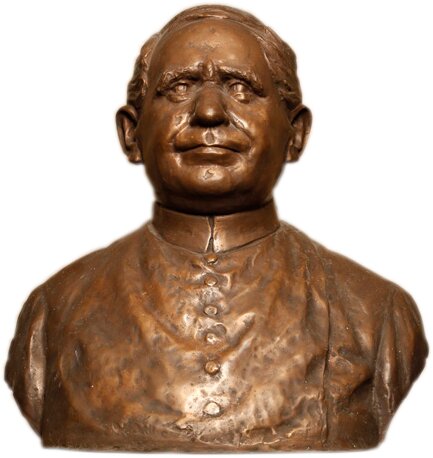
Born at the turn of the 18th and 19th centuries, Ányos Jedlik lived through almost the entire 19th century. From 1840 to 1878, he held the position of the chair of experimental physics at our university. (At that time, the chair consisted of a single professorial position.) Until 1844, he lectured in Latin, and from then on, in Hungarian. In 1848, he was the dean of the Faculty of Arts at our university. At that time, there was no technical university in Hungary; instead, a technical faculty operated under the name Institutum Geometricum at the University of Pest. Jedlik taught there as well. In 1850, he published the first university physics textbook in Hungarian, titled "The Physics of Heavy Bodies." He was elected a regular member of the Hungarian Academy of Sciences in 1858 and served as the university's rector in 1863.
By then, Jedlik had already developed a small machine, for which he consciously applied the creative idea later rediscovered and named the dynamo principle by Siemens. In fact, it wasn't just developed—it was operational! Jedlik used it as a motor to drive the complex apparatus he invented for drawing optical gratings. The university has long preserved the memory of Ányos Jedlik, and another statue of him is housed in the physicists' library.
Ányos Jedlik is the oldest among those whose statues stand in the Hall. Next to him stands the statue of the youngest scientist: László Detre, the astronomer.
Detre László (1906–1974)
 Between 1964 and 1968, he led the Department of Astronomy at our university. He gained international fame for himself and the institute through his research on variable stars. He organized the establishment of an astronomy major in Hungary; prior to this, one could only become a university-educated astronomer with a degree in mathematics-physics teaching or physics. After Miklós Konkoly-Thege, he was the first astronomer to be elected a regular member of the Hungarian Academy of Sciences. Largely thanks to his initiative and organization, Hungary was admitted to the International Astronomical Union after World War II. He was instrumental in establishing and equipping the Piszkéstető observatory of the Academy's Astronomical Research Institute with an excellent Schmidt telescope, as well as a 0.5-meter and later a 1-meter diameter Cassegrain telescope. His memory is preserved by an asteroid discovered and named after him by György Kulin, as well as by a 1-meter diameter commemorative stone erected in his honor by his former colleagues and students at Piszkéstető.
Between 1964 and 1968, he led the Department of Astronomy at our university. He gained international fame for himself and the institute through his research on variable stars. He organized the establishment of an astronomy major in Hungary; prior to this, one could only become a university-educated astronomer with a degree in mathematics-physics teaching or physics. After Miklós Konkoly-Thege, he was the first astronomer to be elected a regular member of the Hungarian Academy of Sciences. Largely thanks to his initiative and organization, Hungary was admitted to the International Astronomical Union after World War II. He was instrumental in establishing and equipping the Piszkéstető observatory of the Academy's Astronomical Research Institute with an excellent Schmidt telescope, as well as a 0.5-meter and later a 1-meter diameter Cassegrain telescope. His memory is preserved by an asteroid discovered and named after him by György Kulin, as well as by a 1-meter diameter commemorative stone erected in his honor by his former colleagues and students at Piszkéstető.
After the statue of László Detre, we find the statue of the professor who led our university's relatively young Department of Meteorology. His name is the least familiar, but this is not by chance.
Száva-Kováts József (1898–1980)
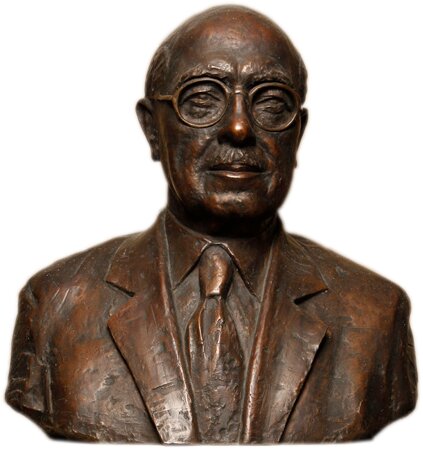 He began his research career as a secondary school teacher. His research findings were published in contemporary international scientific journals. In 1940, he became a private lecturer, in 1943, a public extraordinary professor, and in 1944, he was elected and appointed in 1945 as the professor of the newly established Department of Atmospheric and Climate Science at our university, the first of its kind in Hungary. According to his students, he was a compelling lecturer and a charismatic personality. In 1949, he became and remained the head of the department, which had by then been developed into an institute, until 1953. His book, "The Climate of the Ground-level Layer. Microclimate and Plant Climate," co-authored with Dénes Berényi Sr., was published in 1948. He organized university-level meteorologist training and wrote the first university textbook on the subject, titled "General Atmospheric Science," which was published in 1952. The following year, however, he was removed from his position and interned on fabricated charges. He was released in 1954 but did not regain his position or the opportunity to publish. Although József Száva-Kováts was a student of Cholnoky and earned his doctorate in geography at our university, the science he practiced is now inseparable from physics.
He began his research career as a secondary school teacher. His research findings were published in contemporary international scientific journals. In 1940, he became a private lecturer, in 1943, a public extraordinary professor, and in 1944, he was elected and appointed in 1945 as the professor of the newly established Department of Atmospheric and Climate Science at our university, the first of its kind in Hungary. According to his students, he was a compelling lecturer and a charismatic personality. In 1949, he became and remained the head of the department, which had by then been developed into an institute, until 1953. His book, "The Climate of the Ground-level Layer. Microclimate and Plant Climate," co-authored with Dénes Berényi Sr., was published in 1948. He organized university-level meteorologist training and wrote the first university textbook on the subject, titled "General Atmospheric Science," which was published in 1952. The following year, however, he was removed from his position and interned on fabricated charges. He was released in 1954 but did not regain his position or the opportunity to publish. Although József Száva-Kováts was a student of Cholnoky and earned his doctorate in geography at our university, the science he practiced is now inseparable from physics.
The circle concludes with the statue of Radó Kövesligethy, whom we have already mentioned. He was an astronomer, geophysicist, seismologist, and physicist. He is a worthy representative of the era marked by Loránd Eötvös in the shared history of our university and physics.
Anyone who wants to take one last look at the statues and leave the Hall with a memorable experience should ask to turn on the small lights that illuminate the statues at the reception facing the Danube. If they haven't been lit so far, they may not have been noticed. Everyone who looks around the Hall with these lights on will have a lasting experience.
Text: Gyula Radnai
Photos: Attila Korbely
Editing: Péter Szommer
The Southern Building




Planetarium
The Faculty of Science at ELTE moved to its current building in 1998, and the plan to establish an observatory was already in place. Originally intended for the ground floor, this did not seem advantageous, so it was moved to the rooftop: the planetarium in the center, the spherical observatory next to it, and an observation terrace on the north side. The terrace houses the space research group's radio antenna, which provides real-time images of the Earth's surface. In 1997, when the building was inaugurated, neither the planetarium nor the observatory could be set up due to budgetary constraints. The latter was finally completed in 2004, but the planetarium had to wait until 2011.
The first planetarium was established in Munich in 1923, and it came to Hungary in the 1960s, when it was built in the Amusement Park and later found its permanent home in Pécs until 2004. The Budapest planetarium in Népliget was established in 1977, followed by a similar one in Kecskemét in 1983, and another built in Eger in 2007 as part of the Magic Tower project. The Lágymányos planetarium, completed in 2011, has a dome with an 8-meter diameter, 34 seats, and a star catalog containing 10 million stars. With appropriate software, the projector can display the distribution of groups of celestial objects (galaxies, galaxy clusters, or Milky Way objects) in a 180-degree circular spatial angle, either from Earth or another point in the universe.
The planetarium is primarily used for educational purposes in areas such as astrometry, astronomical geography, galactic astronomy, planetology, the history of astronomy, and archaeoastronomy.


ELTE Natural History Museum
The ELTE Natural History Museum opened its doors on June 18, 2002, on the Lágymányos Campus. Under the glass pyramid, the Biological and Paleontological Collection was established, along with the Mineral Collection, which was relocated from the Trefort Garden and rebuilt in its original state. The museum also now has a Mathematical Collection, housed in the Northern Building.
The predecessor of the Biological and Paleontological Collection was the Zoological and Comparative Anatomy Museum, founded in the 19th century by Professor Tivadar Margó. It was once considered one of the three most beautiful collections in Europe. The collection includes plant and animal fossils, stuffed and living animals, anthropological preparations and tools, anatomical preparations, and research instruments (microscopes, electron microscopes, microtomes, centrifuges, operating tables, etc.). These are all presented to visitors in an organized manner. An important feature of this collection is its daily connection with a university engaged in modern scientific education and research. Some of the anatomical and zoological practical sessions are held in this collection.
The foundation of the Mineral Collection was provided by the collection of Archduchess Maria Anna, the eldest daughter of Maria Theresa, which was purchased by the Hungarian Parliament for the university in 1781 for about 25,000 forints. The original collection has been augmented with numerous special collections over the centuries. The value of the collection has been enhanced not only by quantitative growth but also by its scientific organization and significant role in scientific research. In the new Natural History building completed in 1885 (at the present-day Astoria), two large exhibition rooms, the Mineral Collection and the Rock Collection, were established, allowing the display of about 32,000 specimens. One of these rooms survived the turbulent decades of the 20th century. Its 19th-century furniture, declared a historical monument, was transferred in 2001–2002 after restoration to an arched historical room faithfully designed in one of the modern buildings of the Lágymányos university campus.
The Hungarian Mathematical Museum (MaMa) is the Mathematical Collection of the ELTE Faculty of Science's Natural History Museum. Organized in the early 1990s (initially as the Tibor Bakos Mathematical Collection), one of the museum's goals is to make mathematics visually engaging and to explore its connections with other sciences. The museum places great importance on finding visual aids and models that are useful in illustrating mathematical relationships and theorems. In addition to objects and logical games, the collection includes many mathematics books, popular science books, and magazines. Volumes and collected problems from mathematics competitions also enrich the collection. The legacies of mathematicians often end up in the museum. Numerous models of three-dimensional bodies and shapes can be found in our museum, made from materials such as cardboard, polystyrene, or even straws.


